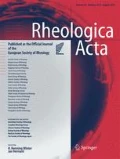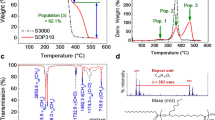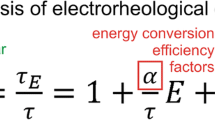Abstract
A four-parameter model (Seo-Seo model) was used to analyze the flow behavior of some electrorheological (ER) fluids containing polypyrrole (PPy) nanoparticles, nanocomposite particles of conductive polypyrrole confined in mesoporous silica (MCM-41), and core-shell-structured SiO2/polypyrrole nanoparticles. The static yield stress predictions by the model were compared with the experimental data and dynamic yield stress obtained from the Bingham model and/or Cho-Choi-Jhon (CCJ) model. The static yield stress values were larger than the dynamic yield stress values. It was also found that the static yield stress of the polypyrrole suspension had a quadratic dependence on the electric field strength as predicted by the electric polarization model whereas those of the nanocomposite suspensions showed 1.5 power-law dependency. A master curve describing the yield stress data dependence on the electric field strength was obtained using a single-parameter scaling function to interpret the underlying mechanism of ER activity. A simple method for evaluating the activity mechanism criterion has been proposed and applied to the ER response of those three kinds of suspension. The results show that the critical electric field strength should be checked before the conduction mechanism is asserted, even if the yield stress plot shows 1.5 power-law dependence on the electric field strength.

Graphical abstract





Similar content being viewed by others
References
Anderson RA (1994) Electrostatic forces in an ideal spherical-particle electrorheological fluid. Langmuir 10:2917–2928
Armes SP (1996) Conducting polymer colloids. Current Opin Colloid Interf Sci 1:214–220
Boissy C, Atten P, Foulc JN (1996) On the role of conductivities and frequency in the electrorheological effect. J Intel Mater Syst Struct 7:599–603
Cheng Q, Pavlinek V, Lengalova A, Li C, He Y, Saha P (2006a) Conducting polypyrrole confined in ordered mesoporous silica SBA-15 channels: preparation and its electrorheology. Micropor Mesopo Mater 93:263–269
Cheng Q, He Y, Pavlinek V, Lengalova A, Li C, Saha P (2006b) Preparation and electrorheology of new mesoporous polypyrrole/MCM-41 suspensions. J Mater Sci 41:5047–5049
Cho MS, Choi HJ, Ahn WS (2004) Enhanced electrorheology of conducting polyaniline confined in MCM-41 channels. Langmuir 20:202–207
Cho MS, Choi HJ, Jhon MS (2005) Shear stress analysis of a semiconducting polymer based electrorheological fluid system. Polymer 46:11484–11488
Choi HJ, Cho MS, Kim JW, Kim CA, Jhon MS (2001) A yield stress scaling function for electrorheological fluids. Appl Phys Lett 78:3806–3808
Choi HJ, Zhang WL, Kim S, Seo Y (2014) Core-shell structured electro- and magneto-responsive materials, fabrication and characteristics. Materials 7:7460–7471
Choi J, Han S, Kim H, Sohn E, Choi HJ, Seo Y (2019) Suspensions of hollow polydivinylbenzene nanoparticles decorated with Fe3O4 nanoparticles as magnetorheological fluids for microfluidics applications. ACS Appl Nano Mater 2:6939–6947
Chuah WH, Zhang WL, Choi HJ, Seo Y (2015) Magnetorheology of core-shell structured carbonyl iron / polystyrene foam nanoparticles suspension with enhanced stability. Macromolecules 48:7311–7319
Davis LC (1992) Polarization forces and conductivity effects in electrorheological fluids. J Appl Phys 72:1334–1340
Davis LC, Ginder JM (1995) In: Havelka KO, Filisko FE (eds) Electrostatic forces in electrorheological fluids progress in electrorheology. Plenum, New York, pp 107–114
Dong YZ, Seo Y, Choi HJ (2019) Recent development of electro-response smart electrorheological fluids. Soft Matter 15:3473–3486
Espin MJ, Delgado AV, Plocharski JZ (2006) Effect of additives and measurement procedure on the electrorheology of hematite/ silicone oil suspensions. Rheol Acta 45:865–876
Fang FF, Liu YD, Choi HJ (2013) Electrorheological and magnetorheological response of polypyrrole/magnetite nanocomposite particles. Colloid Polym Sci 291:1781–1786
Goodwin JW, Markham GM, Vincent B (1997) Studies on model electrorheological fluids. J Phys Chem B 101:1961–1967
Han S, Chi J, Seo YP, Park IJ, Choi HJ, Seo Y (2018) High-performance magnetorheological suspensions of pickering- emulsion-polymerized polystyrene/Fe3O4 particles with enhanced stability. Langmuir 34:2807–2814
Kim DH, Kim YD (2007) Electrorheological properties of polypyrrole and its composite ER fluids. J Ind Eng Chem 13:879–894
Kim YD, Park DH (2002) The electrorheological responses of suspensions of polypyrrole-coated polyethylene particles. Colloid Polym Sci 280:828–834
Kim MW, Moon IJ, Choi HJ, Seo Y (2016) Facile fabrication of core/shell structured SiO2/polypyrrole nanoparticles with surface modification and their electrorheology. RSC Adv 6:56495–56502
Klingenberg DJ (2007) Mason numbers for magnetorheology. J Rheol 51:883–893
Klingenberg D, Ulicny JC, Golden MA (2007) A new mason numbers for magnetorheology, proceedings of the 10th international conference on ERMR 2006 (Eds. Gordaninejad F, Graeve OA, Fuchs A, York D ), pp. 94–100
Liu YD, Choi HJ (2009) Comment on “Preparation and electrorheology of new mesoporous polypyrrole/MCM-41 suspensions”. J Mater Sci 44:2999–3001
Marshall L, Zukoski CF, Goodwin JW (1989) Effects of electric fields on the rheology of non-aqueous concentrated suspensions. J Chem Soc Faraday Trans 85:2785–2795
McIntyre C, Hengxi Y, Green FP (2013) Electrorheology of suspensions containing interfacially active constituents. ACS Appl Mater Interfa 5:8925–8931
Méheust Y, Parmar KPS, Schjelderupsen B, Fossum JO (2011) The electrorheology of suspensions of Na-fluorohectorite clay in silicone oil. J Rheol 55:809–833
Papanastasiou TC (1987) Flows of Materials with Yield. J Rheol 31:385–404
Parathasarathy M, Klingenberg DJ (1996) Electrorheology, mechanisms and models. Mater Sci Eng R 17:57–103
Parmar KPS, Meheust Y, Schjelderupsen B, Fossum JO (2008) Electrorheological suspensions of laponite in oil: rheometry studies. Langmuir 24:1814–1822
Sedlačík M, Mrlík M, Pavlínek V, Sáha P, Quadrat O (2012) Electrorheological properties of suspensions of hollow globular titanium oxide/polypyrrole particles. Colloid Polym Sci. 290:41–48
Seo Y (2011) A new yield stress scaling function for electrorheological fluids. J Non-Newtonian Fluid Mechan 166:241–243
Seo YP, Seo Y (2012) Modeling and analysis of electrorheological suspensions in shear flow. Langmuir 28:3077–3084
Seo YP, Choi HJ, Seo Y (2011) Analysis of the flow behavior of electrorheological fluids with the aligned structure reformation. Polymer 52:5695–5698
Seo YP, Choi HJ, Seo Y (2012) A simplified model for analyzing the flow behavior of electrorheological fluids containing silica nanoparticle-decorated polyaniline nanofibers. Soft Matter 8:4659–4663
Seo YP, Choi HJ, Seo Y (2014) Modelling and analysis of an electrorheological flow behavior containing semiconducting graphene oxide/polyaniline composite particles. Colloids Surf. A. Physicochem Eng Asp 457:363–367
Seo YP, Choi HJ, Seo Y (2015) Yield stress analysis of electrorheological suspensions containing core–shell structured anisotropic poly(methyl methacrylate) microparticles. Polym Adv Tech 26:117–120
Seo YP, Han S, Choi J, Takahara A, Choi HJ, Seo Y (2018) Searching for a stable high-performance magnetorheological suspension. Adv Mater 30:1704769
Wu CW, Conrad H (1996) A modified conduction model for the electrorheological effect. J Phys D Appl Phys 29:3147–3153
Yamaguchi H, Zhang XR, Niu XD, Nishioka K (2010) Investigation of impulse of an ER fluid viscous damper. J Intell Mater Syst Struct 21:423–435
Zhang M, Gong X, Wen W (2009) Manipulation of microfluidic droplets by electrorheological fluid. Electrophoresis 30:3116–3123
Funding
This work was supported by the Institute of Engineering Research at Seoul National University, the KRICT (Korea Research Institute of Chemical Technology) Fundamental Research Program, Korea National Research Foundation (BK21PLUS SNU Materials Division), and POSCO through the project of “RIAM Future Material Solution Center”. HJC appreciates the financial support from the National Research Foundation of Korea (2018R1A4A1025169).
Author information
Authors and Affiliations
Corresponding authors
Additional information
Publisher’s note
Springer Nature remains neutral with regard to jurisdictional claims in published maps and institutional affiliations.
Rights and permissions
About this article
Cite this article
Seo, Y.P., Han, S., Kim, J. et al. Analysis of the flow behavior of electrorheological fluids containing polypyrrole nanoparticles or polypyrrole/silica nanocomposite particles. Rheol Acta 59, 415–423 (2020). https://doi.org/10.1007/s00397-020-01205-9
Received:
Revised:
Accepted:
Published:
Issue Date:
DOI: https://doi.org/10.1007/s00397-020-01205-9




